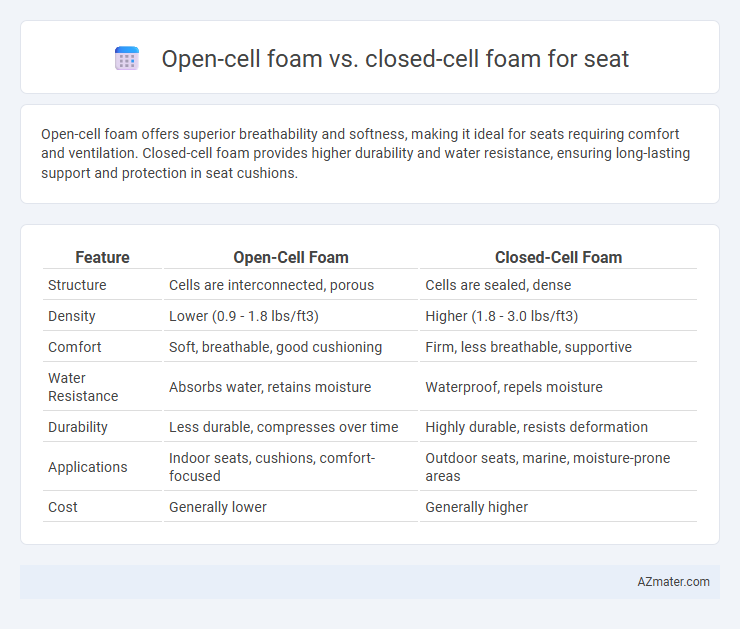Open-cell foam offers superior breathability and softness, making it ideal for seats requiring comfort and ventilation. Closed-cell foam provides higher durability and water resistance, ensuring long-lasting support and protection in seat cushions.
Table of Comparison
| Feature | Open-Cell Foam | Closed-Cell Foam |
|---|---|---|
| Structure | Cells are interconnected, porous | Cells are sealed, dense |
| Density | Lower (0.9 - 1.8 lbs/ft3) | Higher (1.8 - 3.0 lbs/ft3) |
| Comfort | Soft, breathable, good cushioning | Firm, less breathable, supportive |
| Water Resistance | Absorbs water, retains moisture | Waterproof, repels moisture |
| Durability | Less durable, compresses over time | Highly durable, resists deformation |
| Applications | Indoor seats, cushions, comfort-focused | Outdoor seats, marine, moisture-prone areas |
| Cost | Generally lower | Generally higher |
Introduction: Open-cell vs Closed-cell Foam for Seats
Open-cell foam offers a softer, more breathable cushioning ideal for seats requiring enhanced comfort and airflow, while closed-cell foam provides firm support with superior durability and resistance to moisture. In seating applications, open-cell foam typically excels in flexibility and impact absorption, whereas closed-cell foam ensures structural integrity and longevity, particularly in outdoor or high-use environments. Choosing between them depends on balancing comfort needs against durability requirements for optimized seat performance.
What is Open-cell Foam?
Open-cell foam is a lightweight, soft polyurethane material characterized by its porous structure, allowing air to fill the cells, which results in better breathability and cushioning in seat applications. This foam type provides superior comfort by conforming closely to body contours, making it ideal for seating that requires flexibility and pressure relief. While less dense and less moisture-resistant than closed-cell foam, open-cell foam excels in environments where airflow and softness are prioritized.
What is Closed-cell Foam?
Closed-cell foam is a dense, rigid material characterized by tightly packed cells filled with gas, providing superior insulation, moisture resistance, and structural support compared to open-cell foam. Its impermeable nature prevents water absorption, making it ideal for seat cushions exposed to outdoor elements or high humidity. The higher durability and firmness of closed-cell foam enhance comfort and longevity in automotive, marine, and outdoor seating applications.
Comfort and Cushioning Comparison
Open-cell foam offers superior breathability and softness, providing a plush, comfortable seating experience ideal for prolonged use. Closed-cell foam, denser and more rigid, delivers firmer support and enhanced durability, making it suitable for high-impact or outdoor seating applications. The choice between open-cell and closed-cell foam hinges on balancing cushioning softness with structural support tailored to specific seating needs.
Durability and Longevity
Open-cell foam offers excellent breathability and comfort but has lower durability and tends to compress faster, making it less ideal for long-term seat cushioning. Closed-cell foam is denser and more resilient, providing superior durability and maintaining its shape over extended use, which enhances seat longevity. The closed-cell structure also resists moisture and wear better, making it a preferred choice for seats requiring long-lasting performance.
Breathability and Moisture Resistance
Open-cell foam offers superior breathability due to its porous structure, allowing air to circulate and helping seat cushions stay cooler and more comfortable. Closed-cell foam provides excellent moisture resistance by preventing water absorption, making it ideal for environments prone to spills or humidity. Choosing between the two depends on the need for ventilation versus protection from moisture in seat applications.
Weight and Density Differences
Open-cell foam typically has a lower density ranging from 0.9 to 1.8 pounds per cubic foot and weighs less, making it ideal for lightweight seat cushioning. Closed-cell foam, with a higher density between 1.8 to 3.0 pounds per cubic foot, provides greater durability and support at the cost of increased weight. The weight difference significantly affects seat comfort and performance, with open-cell foam offering softer, airier cushioning while closed-cell foam delivers firmer, more resilient support.
Insulation and Temperature Regulation
Open-cell foam offers superior breathability and temperature regulation due to its porous structure, allowing air circulation that prevents heat buildup in seats. Closed-cell foam provides excellent insulation with its dense structure, effectively blocking moisture and retaining warmth, making it ideal for colder environments. Choosing between the two depends on the desired balance of comfort and thermal insulation for seating applications.
Cost Analysis: Open-cell vs Closed-cell Foam
Open-cell foam typically costs less per cubic foot than closed-cell foam due to its lower density and simpler manufacturing process, making it a budget-friendly option for seat cushioning. Closed-cell foam, while more expensive, offers superior durability and water resistance, potentially reducing replacement frequency and long-term costs in high-use or outdoor seating applications. Evaluating initial investment against lifecycle expenses highlights that open-cell foam suits cost-sensitive or indoor environments, whereas closed-cell foam justifies its higher price through enhanced performance and longevity.
Choosing the Best Foam Type for Your Seat
Open-cell foam offers superior breathability and cushioning, making it ideal for seats requiring enhanced comfort and airflow. Closed-cell foam provides higher durability, water resistance, and structural support, making it suitable for outdoor or heavy-use seating. Selecting the best foam type depends on prioritizing comfort and breathability or durability and moisture resistance for your specific seating needs.

Infographic: Open-cell foam vs Closed-cell foam for Seat
 azmater.com
azmater.com